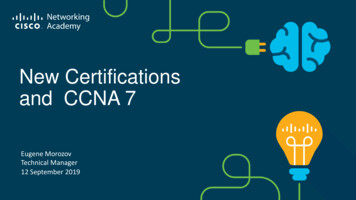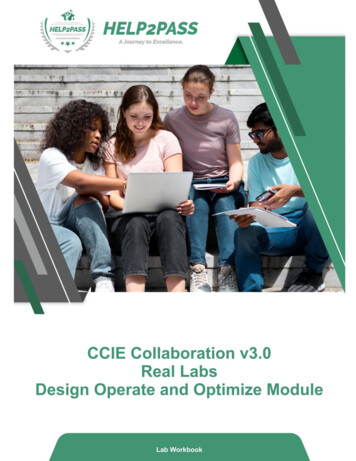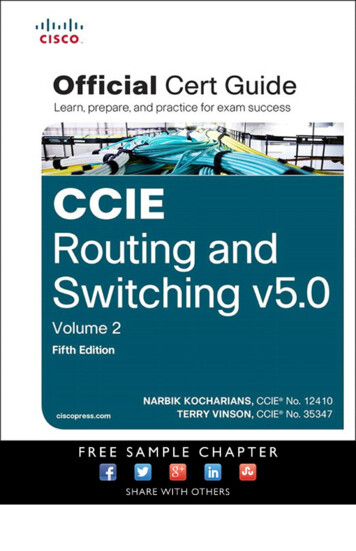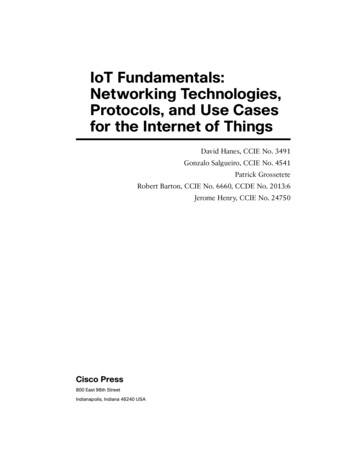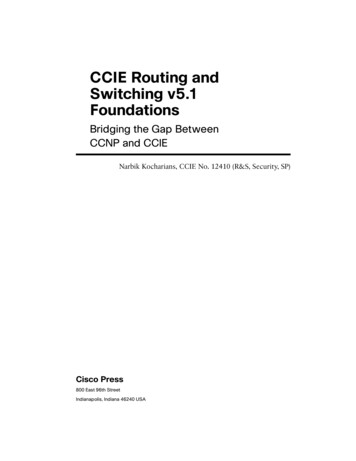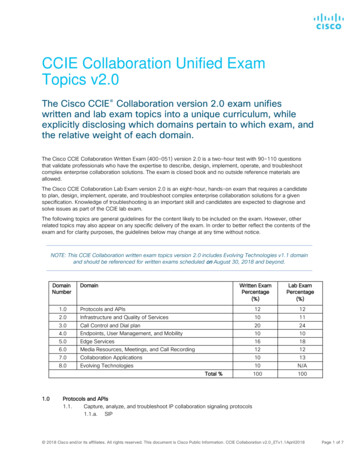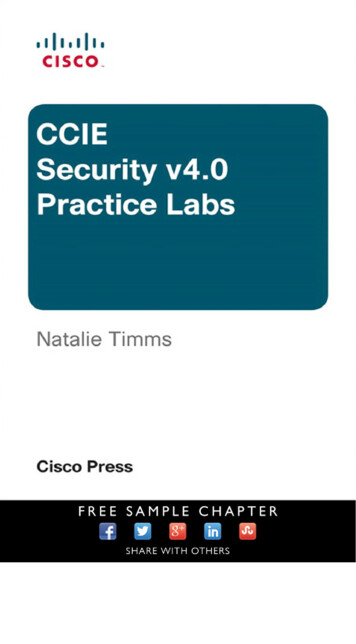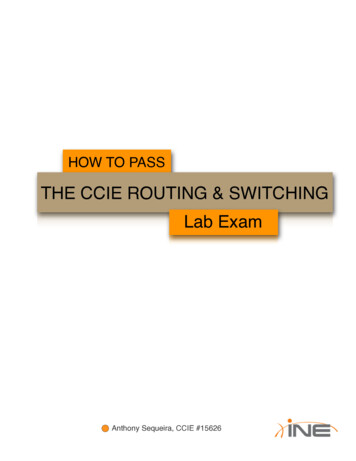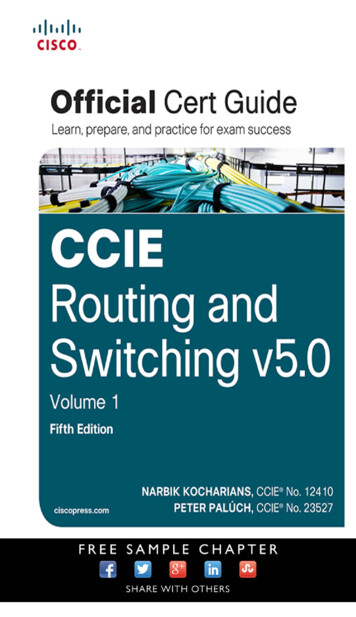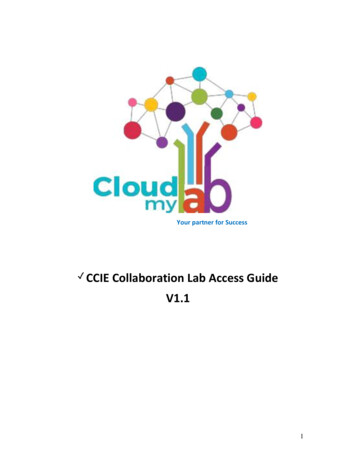
Transcription
Your partner for Success CCIECollaboration Lab Access GuideV1.11
Dear Ms./Mr. Future CCIE Collaboration,Hello!The CCIE Collaboration Lab Access Guide inculcates the details on how to access all thefunctionalities of our Collaboration lab rack/s. To be precise, it describes how to connectsecurely to our CML cloud and connect to our state of the art CCIE Collaboration rack/s.Your CCIE Collaboration rack has: 3 Cisco ISRG2 routers 1 Cisco 3750 Switch 6 Cisco IP Phones directly connected to the Collaboration Lab Rack 1 Service Module Services-Ready Engine(SRE) for Cisco Unity Express 3 Cisco Unified Communications Manager(CUCM) servers, 2 PUBLISHER servers& 1 SUBSCRIBER server 2 Cisco Unity Connection (CUC) servers 2 Cisco IM and Presence (IMP) servers 1 Cisco Unified Contact Center(UCCX) server 1 Video Communications Server (VCS) 1 TelePresence Management Suite (TMS) server 3 Windows machines running Cisco Jabber/RTMT/ 1 Microsoft Active Directory server (labeled “AD/DNS/TFTP/SFTP” in thediagram) 1 access server (not shown) for console port access to routers and switchesPS: Additional infrastructure is not visible to you, nor configurable by you, to reducecomplexity and let you concentrate on the Collaboration Topology.The Lab Rack Diagram in the forthcoming sections shows how all these CollaborationLAB components picture together. The section, “How do I view and control my Cisco IPphones remotely?”, describes how to use software to control IP Phones at the CMLCloud.An Upcoming section “Wow More Tables!!!” the summary of the VLANS, IP subnets,Routers and Ether Switch port connections, Digital Signal Processing resources, T1/E1connections and PSTN access codes.2
Please note that in the past the following site names have been used interchangeably:Corp HQ HQ SA SiteABranch 1 BR1 SB SiteBBranch 2 BR2 SC SiteCThroughout this guide and subsequent labs, you should come to see everything referredto simply as:CML-HQCML-SBCML-SC3
Table of ContentsGetting Access to the POD . 51) Accessing the Devices console . 112) Virtual Machine based Device Access . 113) Physical Machine based Device Access . 11Example Method 1 for Virtual Devices with CLI access . 12Example Method 2 for Virtual Devices with CLI Access. 13Example Method 1 for windows based Device: . 14Example Method 2 for windows based Device: . 15Lab Shortcuts . 16NEED HELP? . 184
Getting Access to the PODThere are two ways you may get access to the lab access details as mentioned below:1. Check for the Url and Port Number in the email from support@cloudmylab.comFigure 1:2. You can alternately log in to your account and under my account Rack access,you will see the detail:Figure 2:5
3. Login with the credentials provided:Figure 3:4. Once logged in you, will see a customized Desktop i.e. Candidate PC, from whereyou can access all the device command lines and GUIs.Let’s Lock and Load:This opens an interface which resembles the Cisco Collaboration Lab experience.1. Before you start your lab you must reset the Lab configuration to a baseconfiguration. This can be achieved by navigating to the “BEGIN LAB” folder onthe Candidate PC.Figure 4:6
2. Launch VMWare Vshpere client using the VMWare client shortcut availableinside the “BEGIN LAB” folder:Figure 5:3. Use the following user name and password to login to the VMWare client:Username: administratorPassword: cciecollabFigure 6:7
4. Once inside the VMware Vsphere client revert to base configuration using theSnapshot Manager for every machine in view as illustrated in the following twosteps:STEP 1) For example you need to get the Collab-HQ PUB to its basedconfiguration.Collab-HQ PUB – Right Click – Select Snapshot – Choose Snapshot ManagerFigure 7:STEP 2) Once the available snapshots show up, select the snapshot named BASECollab-HQ PUB and click “Go to”.Figure 8:8
5. Navigate to the Secure CRT shortcut available in the “BEGIN LAB” folder:Figure 9:6. Launch the Secure CRT application to get to Command Lines of the ISRG2’s andswitches:Figure 10:9
7. Next, bring all the routers and switches to their base configurations as under:Open the physical device console login dir flash: #copy flash:CMLRW1BASE.cfgstartupReloadCheck out the video: https://www.youtube.com/watch?v I72ExquNIFANOTE: Sometimes the remote IOS device may refuse the connection.Figure 11:Solution: Use the “Clear All Lines” or “Clear Line HQ/SB/SC”Figure 12:10
Accessing the Device Console8. Physical Device Access: – All the devices are pre-setup for console access. Followthe screenshots for quick access.Virtual Machine based Device Access (GUI)RACK WEST – 1Server/DeviceCollab-HQ PUBCollab-HQ SUBCollab-HQ CUCCollab-HQ CCXCollab-HQ IMPCollab-SB PUBCollab-SB CUCCollab-SB IMPCollab-WIN7-1Collab-WIN7-2CollabCandidate PCCollab-TerminalServerCollab NTPServerDescriptionHQ CUCM PUBLISHERHQ CUCM SUBSCRIBERHQ UNITY CONNECTIONHQ CONTACT CENTRE EXPRESSHQ IM &PRESENCESB CUCM PUBLISHERSB UNITY CONNECTIONSB IM &PRESENCEHQ WIN PC for Cisco JABBERSB WIN PC for Cisco JABBERIP 2.100.65.15142.100.64.21142.100.65.21Candidate WIN orCCIECOLLAB\collabstudentCollab TERM SERVERNO ACCESSNO ACCESSBB NTP Server149.132.1.23NO llabcciecollabccie123NOACCESSNOACCESSPhysical Machine based Device DescriptionHQ VOICE GATEWAYSB VOICE GATEWAYSC VOICE GATEWAYHQ SWITCHIP bcciecollabcciecollab11
A3) Follow the Screen shots for Quick Access1. Click on SecureCRTFigure 13:Example Method 1 for Virtual Devices with CLI accessOpen SecureCRT Click on the Plus Sign against Virtual Device Select the relevantdeviceFigure 14:12
Example Method 2 for Virtual Devices with CLI AccessOpen Vmware Vsphere Client right click on the relevant machine click open consoleFigure 15:13
Example Method 1 for windows based Device:Click on the remote desktop shortcut on the desktop, you will see 4 shortcuts andnamed appropriatelyEnter the username and password when promptedFigure 16:14
Example Method 2 for windows based Device:Open Vmware Vsphere Client right click on the relevant machine click open consoleFigure 17:15
Lab Shortcuts9. Starting a lab with Specific configurationOpen the physical device console login dir flash:#copy flash: lab1.cgf startupReloadCheck out the video: https://www.youtube.com/watch?v I72ExquNIFAClearing console line to get access: Under SecureCRT click on the plus sign againstClear line and Select relevant device to clearFigure 18:16
Reloading the devices: All the devices are connected to managed power PDU and youcan use the shortcut to boot the devicesFigure 19:NOTE:Site C – Do not shut the following two interfaces:interface GigabitEthernet0/1/2interface GigabitEthernet0/1/317
NEED HELP?To get support open a ticket on Support Page or send an email tosupport@cloudmylab.comPlease check the documentation and FAQs before hand18
The CCIE Collaboration Lab Access Guide inculcates the details on how to access all the functionalities of our Collaboration lab rack/s. To be precise, it describes how to connect securely to our CML cloud and connect to our state of the art CCIE Collaboration rack/s.
